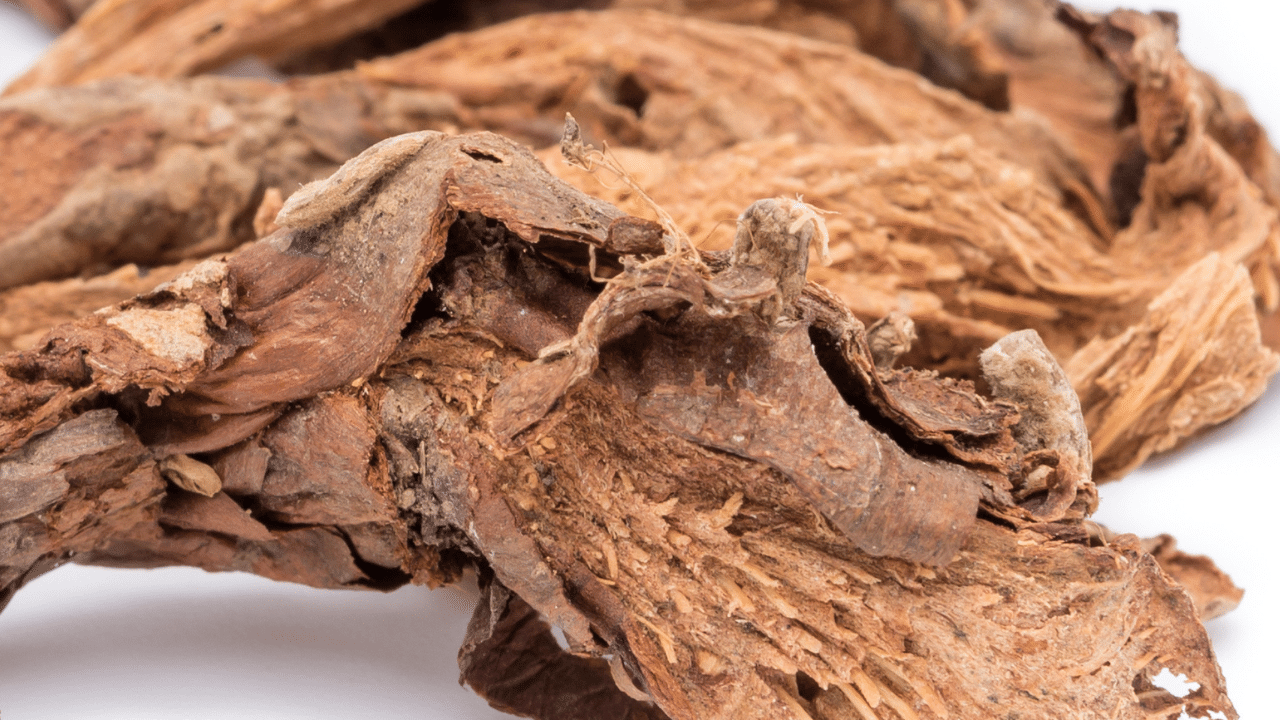Ghandi Root Oil: Peaceful Perseverance

Ghandi Root
Ghandi Root (Homalomena aromatica), an evergreen perennial, belongs to the Family Araceae, which is the most diverse plant family in the New World Tropics!
This essential oil-bearing plant’s native range occupies the tropical and subtropical forests from Assam to China.
Ghandi Root is identifiable by its heart-shaped leaves and orange yellow berries (Kew RBC, 2020) (Figure 1).
 Figure 1. Ghandi Root (Homalomena aromatica)
Figure 1. Ghandi Root (Homalomena aromatica)
Traditional medicine
This plant’s rhizome (a modified plant stem below the ground) has been used in traditional herbal medicine for over 3000 years to treat a range of conditions based on its reported analgesic, antidepressant, anti-inflammatory, antiseptic, antispasmodic, sedative, and antifungal properties (Policegoudra et al., 2012; Rhind, 2019).
Essential oil components and therapeutic benefits
The source of Ghandi Root steam-distilled essential oil is also the rhizome, so its use in traditional medicine may overlap with its use in aromatherapy in part because of its two primary constituents: linalool (62.1%), and terpinen-4-ol (17.2%) (Singh et al, 2000).
Linalool, also found as a predominant constituent in true lavender (Lavandula angustifolia), clary sage (Salvia sclarea) and ho leaf (Cinnamomum camphora) linalool CT essential oil has anticonvulsant, sedative, anxiolytic, and antispasmodic properties. Terpinen-4-ol, also found in tea tree (Melaleuca alternifolia), marjoram (Origanum marjorana), frankincense (Boswellia neglecta), and kewda (Pandanus fascicularis) essential oil has anti-inflammatory, antimicrobial, antifungal, and anticholinesterase activities. In addition to linalool and terpinen-4-ol, Ghandi Root essential oil contains alpha-terpineol (2.4%), gamma-terpinene (1.9%), alpha-cadinol (1.5%), geraniol (1.4%) nerol (1.4%), alpha-terpinene (1.0%), spathulenol (1.0%), and tau-cadinol (1.0%) (Singh et al., 2000).
Ghandi Root essential oil is beneficial for nervous tension, anxiety, insomnia, microbial infections, immune system stimulation, epilepsy, and for conditions that cause muscle spasms.
Fragrance and safety
Ghandi Root oil’s fragrance profile can be described as woody-herbaceous, sweet pungent, and earthy, which together reflect the oil’s grounding, calming and tonifying energetic qualities (G. Mojay, personal communication, May 8, 2020). Further, this unique oil has no known hazards and contraindications (Tisserand and Young, 2014).
Conservation
Although this plant has not yet been classified by the IUCN, it is important to ethically source its essential oil. There are reports that, because of commercial and unregulated harvesting practices in certain parts of India, this plant is threatened (Raomai, 2013). Always ensure that you ethically source this essential oil from cultivated plants under sustainable management.
Recipe for anxiety inhaler
- Ghandi root (Homalomena aromatica) essential oil - 10 drops
- True lavender (Lavandula angustifolia) essential oil - 5 drops
- Sweet orange (Citrus sinensis) essential oil - 10 drops
Inhale for 3-5 minutes when needed
Wishing you an aromatic day!
About Essence of Thyme College of Holistic Studies
Essence of Thyme College of Holistic Studies offers 300- and 630-hour professional aromatherapy certification programs that help you grow a successful, fulfilling career by specializing and creating your market niche. Professional Level Certification prepares graduates to become aromatherapy consultants, launch product lines or retail businesses, or provide services as an adjunct to existing holistic health specializations. Master Level Certification and electives are ideal for certified aromatherapists seeking higher education or a path to clinical aromatherapy practice.
All Essence of Thyme programs focus on aromatherapy product development and advanced formulation, evidence-based research, spa and business management, international industry regulatory guidelines, and sustainability and conservation of essential oil and carrier oil-bearing plants.
Our comprehensive, evidence-based programs meet or exceed the criteria set forth by 5 international professional aromatherapy associations. Learn more about our aromatherapy certification programs.
References
Kew Royal Botanic Gardens. Plants of the World Online. www.plantsoftheworldonline. Accessed May 1, 2020.
Policegoudra, R.S., Goswami, S., Aradhya, S, et al. (2012). Bioactive constituents of Homalomena aromatica essential oil and its antifungal activity against dermatophytes and yeasts. Journal de Mycologie Medicale, 22(1), 83-87.
Raomai, S, Kumaria, S., and Tandon, P. (2013). In vitro propagation of Homalomena aroamtica Schott., and endangered aromatic medicinal herb of Northeast India. Physiology and Molecular Biology of Plants, 19, 297-300.
Rhind, J.P. (2019). Essential Oils. A Handbook for Aromatic Therapy (3rd ed). London, UK: Singing Dragon.
Singh, G., Kapoor, I.P., Singh, O.P., et al. (2000). Chemical composition, antifungal and insecticidal activities of rhizome volatile oil of Homalomena aromatica. Flavour and Fragrance Journal, 15, 278-280.
Tisserand, R. & Young, R. (2014). Essential Oil Safety. A Guide for Healthcare Professionals (2nd ed.). London, UK: Elsevier.
Photo by S.T. Edwards - Curtis’s Botanical Magazine, vol. 49: t. 2279 (1822), Public Domain, https://commons.wikimedia.org/w/index.php?curid=17178059


